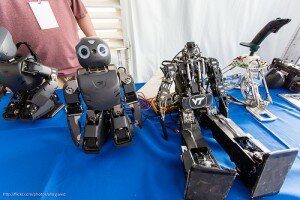 Robotics is a tremendously exciting industry, and the sector is at a point in its history that we’ve never seen before. According to industry trade group the there was a new peak in robot orders and shipments in North America this year: 31,464 robots, valued at $1.8 billion dollars, were ordered from North American companies during 2015.
Robotics is a tremendously exciting industry, and the sector is at a point in its history that we’ve never seen before. According to industry trade group the there was a new peak in robot orders and shipments in North America this year: 31,464 robots, valued at $1.8 billion dollars, were ordered from North American companies during 2015.
This is an increase by 14% in units from 2014, and this number is only expected to grow. According to Jeff Burnstein, president of the RIA, “Today, there are more opportunities than ever before in the robotics industry. The continuing growth in robotics is opening many new job opportunities for people who can program, install, run, and maintain robots. In fact, if you look closer at the jobs discussion, automation is helping to save and create jobs. A lot of companies tell us they wouldn’t be in business without robotics and related automation.”
In other words, if you’re interested in robotics, the time to learn more is now. In the last year, companies have been breaking down stereotypes of what robots are, or could be, to create entirely new varieties of robots. Some are fun and humorous, and others have the potential to change life as a human for the better. In either regard, we’ve come a long way. Here are some of the exciting creations that researchers have been developing lately:
These little guys are the talk of the tech world these days. The palm-sized robot, known as CRAM (compressible robot with articulated mechanisms), is capped with a plastic shield, like the wings on the back of a cockroach. American scientists designed CRAM to one day help locate people in the rubble of earthquakes, tornadoes, or explosions.
Lead researcher Kaushik Jayaram, a postdoctoral fellow at Harvard University, says that “what’s impressive about these cockroaches is that they can run as fast through a quarter-inch gap as a half-inch, by reorienting their legs completely out to the side. They can squish their bodies to one-tenth of an inch—the height of two stacked pennies.” While we never hope for a natural disaster, it’s a comfort to know that these little guys could be there when the time comes.
Interestingly enough, Disney’s research division has pioneered some really exciting research in robotics. Their latest system is a 3D printed soft skin that provides a buffer between the robot’s frame and anyone touching it, theoretically to keep children who interact with robots safer.
Because robots are interactive, children love to play with them, but the moving parts and stiff machines can injure them easily. This skin also has pressure sensors that can measure the level of force being applied by a robot to make sure that both children and robot are safe during the interaction.
This robot starts as a postage-sized wafer, and assembles itself when it’s placed on a heated surface. Once it’s done so, it can carry loads twice its weight, swim, and even dissolve itself. While the robot is tiny today, this technology applied to a larger creature could have massive potential.
As Digital Trends explains, “the amazing thing is that, by doing little more than changing the frequency of the magnetic field, it’s possible to steer the bot around and have it perform various tasks.” Watch the video at the link above to see it action.
Robotics is one of the most exciting fields of technology that exist, and there are subfields and all sorts of areas that are yet to be explored. Questions? Comments? Want to learn more? Leave a comment in the section below!
—
photo credit: via
 Official Nebraska Government Website
Official Nebraska Government Website
